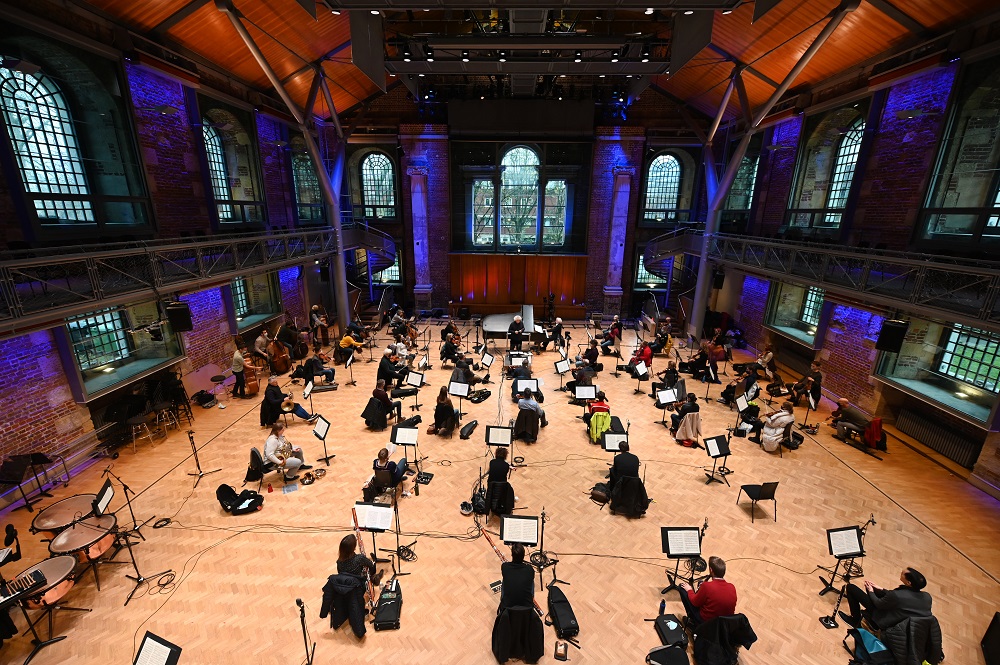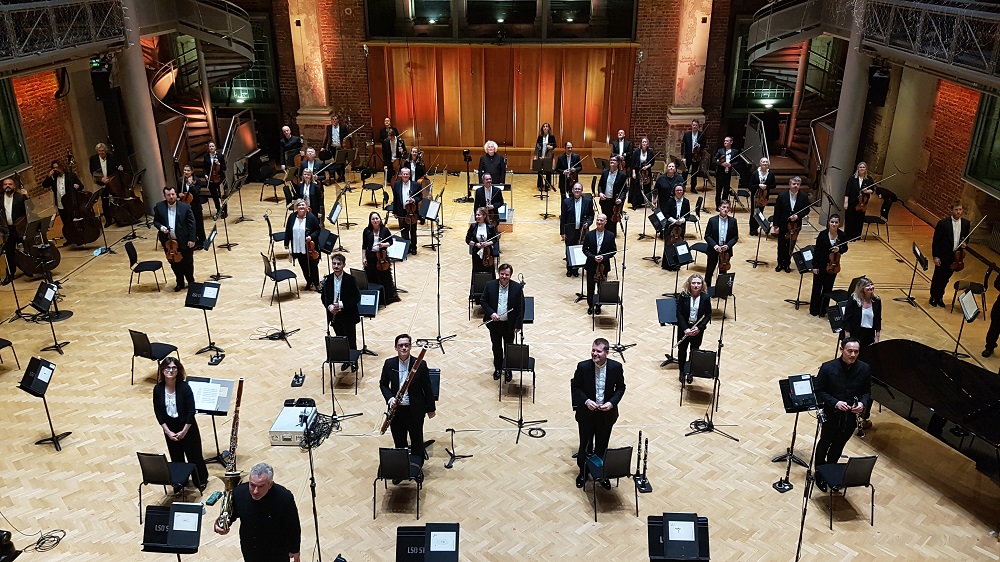Zimerman, LSO, Rattle, LSO St Luke's review - rainbow colours, continuity and imperial soaring | reviews, news & interviews
Zimerman, LSO, Rattle, LSO St Luke's review - rainbow colours, continuity and imperial soaring
Zimerman, LSO, Rattle, LSO St Luke's review - rainbow colours, continuity and imperial soaring
The richest of palettes applied to Beethoven, while Stravinsky sings and dances
Adaptability backed up by funding has been the course of the most successful musical organisations since mid-March – but it’s been especially tough from November onwards.
Zimerman, who’s arguably been producing the most beautiful range of sounds a pianist can from a keyboard since he won the Ninth International Chopin Competition as a fresh-faced young man in 1975, recorded the Beethoven concertos 30 years ago with Bernstein. His questing spirit has not stayed still, or ossified; if anything, the forward movement is now more impulsive, the freedom to play with ideas differently on their second or third appearances even more surprising (I’m thinking especially of the cantering theme in the finale of the Second Piano Concerto, but all these last movements have equal sparkle). And it’s a joy to see him living the music when he’s not playing, in responsive action with the players and Rattle – who knows how to pick up with the orchestra from his sudden spontaneities, a watchful eye indeed.  The respectful teamwork (afternoon session pictured above) allows for an interplay of pianist and woodwind players you’d expect more from a late Mozart concerto. The first movement of the Third here, featured in the first session on Zimerman’s birthday, is revelatory to me in that respect; the LSO’s wind team on this occasion featured oboist Juliana Koch, to be featured next year, plans permitting, in the Strauss Oboe Concerto, but her co-principal Olivier Stankiewicz is also outstanding. Lovely work, too, from first clarinettist Chris Richards.
The respectful teamwork (afternoon session pictured above) allows for an interplay of pianist and woodwind players you’d expect more from a late Mozart concerto. The first movement of the Third here, featured in the first session on Zimerman’s birthday, is revelatory to me in that respect; the LSO’s wind team on this occasion featured oboist Juliana Koch, to be featured next year, plans permitting, in the Strauss Oboe Concerto, but her co-principal Olivier Stankiewicz is also outstanding. Lovely work, too, from first clarinettist Chris Richards.
The second concert seems to have a touch more tension, not unhelpful in the central conflict between Orpheus and the Furies in No 4. No 2 feels bigger, less Mozartian, than usual, but that may be to adapt to the scale of its remarkable first-movement cadenza. The final event in the series is certainly that, hitting the heights from the off with a newly-expanded orchestra. Zimerman unleashes his most magisterial sonorities at the start; the orchestra responds by soaring like an eagle – I don’t think I’m imagining the special ode-to-joy quality in this performance of a work which can seem too over-emphatic in its heroism. The first movement simply rides the thermals unerringly until the explosions at the heart of the development, after which it slowly eases itself down – more magical work from the soloist here – the better to fly again in the recap. Nowhere is Zimerman’s singular sense of continuity more beautifully articulated than in that transition from time-standing-still slow movement to airy burst of exuberance to kickstart the finale, but ever so elegantly.  Olympus preceded imperial heaven in this session: a huge complement of strings, Karajan-style, for Stravinsky’s ballet Apollo, the beginning of his auspicious partnership with that greates of choreographers George Balanchine. It can work with a chamber orchestra, but Rattle (pictured above) drew a focused sensuousness in the resonance of arching phrases and gorgeous divisi from a full LSO department. In between came many glinting, flashing solos, led by ever-companionable, alert and considerate leader Roman Simovic, further gilded by cellist Rebecca Gilliver in the haunting refrains of the Pas de deux. I was lucky to be present at the full Stravinsky session on the evening before lockdown: a glorious 100 minutes taking us from eight musicians to a big orchestra occupying the entire floor space of St Luke’s below the gallery where we lucky spectators observed the interplay and obvious rapport of an orchestra which has become so much more of a team since Rattle took over.
Olympus preceded imperial heaven in this session: a huge complement of strings, Karajan-style, for Stravinsky’s ballet Apollo, the beginning of his auspicious partnership with that greates of choreographers George Balanchine. It can work with a chamber orchestra, but Rattle (pictured above) drew a focused sensuousness in the resonance of arching phrases and gorgeous divisi from a full LSO department. In between came many glinting, flashing solos, led by ever-companionable, alert and considerate leader Roman Simovic, further gilded by cellist Rebecca Gilliver in the haunting refrains of the Pas de deux. I was lucky to be present at the full Stravinsky session on the evening before lockdown: a glorious 100 minutes taking us from eight musicians to a big orchestra occupying the entire floor space of St Luke’s below the gallery where we lucky spectators observed the interplay and obvious rapport of an orchestra which has become so much more of a team since Rattle took over.
Simply the sound of the woodwind and brass tuning up before the Symphonies of Wind Instruments, following a punchy but also mellifluous Octet, was unusually exciting: a seething aural sea beneath, if you’ll forgive the muddied metaphorical fantasy. Blendings on that vast scale were as impeccable as those of pairs within the opening eight. Centrepiece was Orpheus, a more austere and dark response to Apollo, paradoxically with a wider orchestral palette (some atmospheric sonorities to be had from sitting above the halo of strings while trumpets sounded far to the right).  Stravinsky when he writes tends to put inverted commas around “heart”, but there is little more moving in his mercurial output than the Air de Danse led by two oboes – the second later replaced with extra poignancy by cor anglais – which emulates Bach, rising to its model rather than parodying or distorting it. With this number of strings the Beethovenian nobility of Orpheus’s Pas de deux with Eurydice before he looks back made one sit bolt upright; the ritual ripping-apart of the hero by the Furies was electric, the final apotheosis quietly stunning.
Stravinsky when he writes tends to put inverted commas around “heart”, but there is little more moving in his mercurial output than the Air de Danse led by two oboes – the second later replaced with extra poignancy by cor anglais – which emulates Bach, rising to its model rather than parodying or distorting it. With this number of strings the Beethovenian nobility of Orpheus’s Pas de deux with Eurydice before he looks back made one sit bolt upright; the ritual ripping-apart of the hero by the Furies was electric, the final apotheosis quietly stunning.
Then, twelve brisk encores (final bow to the balcony pictured above by David Thompson) with continuity between most of them in the shape of the Four Norwegian Moods, adapted from unused music for a Second World War film, and the First and Second Suites, playing on various pieces for children (simple left hand, complicated right, and vice versa). The final raucous Galop proved a suitable nose-thumbing to the lockdown shortly to follow, who knows for how long? But the filmed events – the Stravinskys will be released anon – should provide more than a little consolation in the meantime.
The future of Arts Journalism
You can stop theartsdesk.com closing!
We urgently need financing to survive. Our fundraising drive has thus far raised £49,000 but we need to reach £100,000 or we will be forced to close. Please contribute here: https://gofund.me/c3f6033d
And if you can forward this information to anyone who might assist, we’d be grateful.

Subscribe to theartsdesk.com
Thank you for continuing to read our work on theartsdesk.com. For unlimited access to every article in its entirety, including our archive of more than 15,000 pieces, we're asking for £5 per month or £40 per year. We feel it's a very good deal, and hope you do too.
To take a subscription now simply click here.
And if you're looking for that extra gift for a friend or family member, why not treat them to a theartsdesk.com gift subscription?
more Classical music
 BBC Proms: Akhmetshina, LPO, Gardner review - liquid luxuries
First-class service on an ocean-going programme
BBC Proms: Akhmetshina, LPO, Gardner review - liquid luxuries
First-class service on an ocean-going programme
 Budapest Festival Orchestra, Iván Fischer, Edinburgh International Festival 2025 review - mania and menuets
The Hungarians bring dance music to Edinburgh, but Fischer’s pastiche falls flat
Budapest Festival Orchestra, Iván Fischer, Edinburgh International Festival 2025 review - mania and menuets
The Hungarians bring dance music to Edinburgh, but Fischer’s pastiche falls flat
 Classical CDs: Hamlet, harps and haiku
Epic romantic symphonies, unaccompanied choral music and a bold string quartet's response to rising sea levels
Classical CDs: Hamlet, harps and haiku
Epic romantic symphonies, unaccompanied choral music and a bold string quartet's response to rising sea levels
 Kolesnikov, Tsoy / Liu, NCPA Orchestra, Chung, Edinburgh International Festival 2025 review - transfigured playing and heavenly desire
Three star pianists work wonders, and an orchestra dazzles, at least on the surface
Kolesnikov, Tsoy / Liu, NCPA Orchestra, Chung, Edinburgh International Festival 2025 review - transfigured playing and heavenly desire
Three star pianists work wonders, and an orchestra dazzles, at least on the surface
 BBC Proms: Láng, Cser, Budapest Festival Orchestra, Iván Fischer review - idiomatic inflections
Bartók’s heart of darkness follows Beethoven’s dancing light
BBC Proms: Láng, Cser, Budapest Festival Orchestra, Iván Fischer review - idiomatic inflections
Bartók’s heart of darkness follows Beethoven’s dancing light
 Weilerstein, NYO2, Payare / Dueñas, Malofeev, Edinburgh International Festival 2025 review - youthful energy and emotional intensity
Big-boned Prokofiev and Shostakovich, cacophonous López, plus intense violin/piano duo
Weilerstein, NYO2, Payare / Dueñas, Malofeev, Edinburgh International Festival 2025 review - youthful energy and emotional intensity
Big-boned Prokofiev and Shostakovich, cacophonous López, plus intense violin/piano duo
 theartsdesk at the Three Choirs Festival - Passion in the Cathedral
Cantatas new and old, slate quarries to Calvary
theartsdesk at the Three Choirs Festival - Passion in the Cathedral
Cantatas new and old, slate quarries to Calvary
 BBC Proms: Estonian Philharmonic Chamber Choir, Kaljuste review - Arvo Pärt 90th birthday tribute
Stillness and contemplation characterise this well sung late-nighter
BBC Proms: Estonian Philharmonic Chamber Choir, Kaljuste review - Arvo Pärt 90th birthday tribute
Stillness and contemplation characterise this well sung late-nighter
 BBC Proms: Kholodenko, BBCNOW, Otaka review - exhilarating Lutosławski, underwhelming Rachmaninov
Polish composers to the fore in veteran conductor’s farewell
BBC Proms: Kholodenko, BBCNOW, Otaka review - exhilarating Lutosławski, underwhelming Rachmaninov
Polish composers to the fore in veteran conductor’s farewell
 theartsdesk at the Pärnu Music Festival 2025 - Arvo Pärt at 90 flanked by lightness and warmth
Paavo Järvi’s Estonian Festival Orchestra still casts its familiar spell
theartsdesk at the Pärnu Music Festival 2025 - Arvo Pärt at 90 flanked by lightness and warmth
Paavo Järvi’s Estonian Festival Orchestra still casts its familiar spell
 BBC Proms: Batsashvili, BBC Scottish Symphony Orchestra, Ryan Wigglesworth review - grief and glory
Subdued Mozart yields to blazing Bruckner
BBC Proms: Batsashvili, BBC Scottish Symphony Orchestra, Ryan Wigglesworth review - grief and glory
Subdued Mozart yields to blazing Bruckner

Add comment